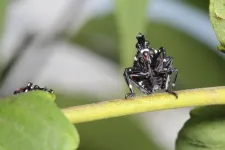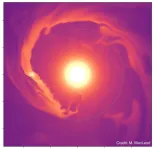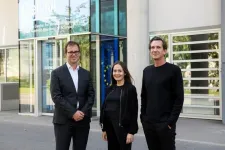(Press-News.org) Key takeaways
Ants can either forage for food as individuals or recruit other members of their colonies to help search for or carry food back to their nests.
UCLA biologists found that the strategies ants use to forage play a bigger role in how they build their nests than innate, evolutionary “blueprints” do.
When building nests, ants strike a balance between transportation efficiency and architectural constraints. Researchers say that observation could help humans design more efficient transportation systems tailored to specific needs.
Could ants’ nests hold the secret to reducing traffic congestion on the 405 Freeway?
In a new study, UCLA biologists discovered insights about how ants build their nests that could be useful for designing more efficient human transportation systems.
The scientists were interested in learning whether the way ants build their nests is more influenced by the evolutionary history of each individual species or current ecological conditions. What they found was that evolution could not explain the variations they observed among different species’ nests. Rather, they found, the environments in which ants forage and the way they transport food are the main factors that dictate how each species builds its nests.
The lesson for humans? If roads were better tailored to the ways goods and people move through our cities, transportation networks could be more efficient. For example, congestion on Southern California’s freeways might be improved if there were dedicated lanes or roads for trucks traveling to and from major logistics hubs like ports, warehouses and distribution centers.
“Ants deal with the same issues we deal with when it comes to living in crowded spaces,” said Sean O’Fallon, a UCLA doctoral student in ecology and evolutionary biology, and the study’s first author. “We’re densely packed in cities, and ideally we should be densely connected, but there are constraints to how closely packed together we can be. There’s only so much space to construct buildings and roads.”
In the study, published in Philosophical Transactions of the Royal Society B, scientists analyzed information from two sources — details about 397 ant nests came from previously published data and images, and the authors conducted new studies of 42 other nests, all located at the Archbold Biological Reserve near Venus, Florida. In total, the 439 nests represented 31 different species of ants.
They discovered that nest structures were largely determined by factors like whether ants foraged alone or in groups, as well as the methods they used to recruit other ants to help find and carry food. In a nutshell, the animals’ activity and behavior play bigger roles in nest construction than any innate evolutionary template.
“You can think of the nest itself as a transportation network — it’s where ants live, but it’s also a kind of highway network they move things in and out of,” said Noa Pinter-Wollman, a UCLA professor of ecology and evolutionary biology and the paper’s corresponding author.
The researchers examined four common foraging strategies used by ants. In some species, individual ants hunt for food. In others, an ant brings food to the nest as a means of recruiting other ants to accompany it to the food source. Ants can also form a continuous trail between the food source and the nest that can persist for months. Or they can leave a pheromone trail that members of the colony can follow in large numbers — a phenomenon the researchers called “mass recruitment.”
Ants’ nests consist of a tunnel leading down to an entrance chamber, where ants enlist other members of their colony to help them find or transport food. From the entrance chamber, tunnels lead down to other chambers, which are connected by tunnels to still deeper chambers. Chambers serve different purposes, such as food and waste storage and rearing young.
The researchers expected that in ant species that use the mass recruitment style of foraging, the nests’ entrance chambers would be larger than they are in other species’ nests, because those spaces would need to allow larger numbers of ants to interact. And indeed, they found that to be the case.
However, the scientists also expected that nests for the mass recruitment foragers would have greater “network density” — meaning larger numbers of connections among the chambers — than nests built by other species. Greater network density, the scientists reasoned, would help facilitate more movement of ants and resources throughout the nest.
But the research revealed that for ants representing all four foraging strategies, network density was relatively low — even for large nests with hundreds of chambers. In fact, the study revealed, across all foraging strategies, nests with the most chambers tended to have the lowest network density.
In the paper, the researchers write that finding could be simply a function of architecture: Too many tunnels between chambers could weaken the structural integrity of the nest, which could cause the entire system to collapse.
“Ants have to balance the efficiency of highly connected nests with architectural stability,” Pinter-Wollman said. “On one hand, they want transportation to be faster, but if they start making too many connections, the nest will crumble.
END
Could insights from ants help people build better transportation networks?
UCLA study finds the insects’ nests reflect the way they work together – or don’t – to forage for food
2023-09-01
ELSE PRESS RELEASES FROM THIS DATE:
Invasive spotted lanternfly may not damage hardwood trees as previously thought
2023-09-01
UNIVERSITY PARK, Pa. — In 2012, when the spotted lanternfly (Lycorma delicatula) arrived in the U.S. from its home in China, scientists, land managers, and growers were understandably concerned that the sap-feeding insect would damage native and commercial trees. New long-term research led by Penn State has discovered that hardwood trees, such as maple, willow and birch, may be less vulnerable than initially thought.
“Since the lanternfly was first introduced to the northeastern U.S., the question has been, ‘How at-risk are our forests?’ said Kelli Hoover, professor of entomology at Penn State. “So far, we haven't had a good answer. Our study is the first ...
$26M NIH grant addresses environmental influences on child health
2023-09-01
EAST LANSING, Mich. – Backed by a $26 million federal grant, researchers at three Michigan universities, a leading health care system, and a state agency will continue a long-term study of how exposure to environmental factors during pregnancy and early childhood can impact health for a lifetime.
The funding from the National Institutes of Health, or NIH, is for the second phase of a national research program called ECHO, which stands for the Environmental Influences on Child Health Outcomes, and includes a sample of mothers, infants and children from across the United States. The first phase began in 2016.
“This award shows the research ...
LDL not the be all, end all in heart disease, heart attacks and stroke
2023-09-01
Milwaukee, Wis. – Sept. 1, 2023 – Despite advances in treatment for high cholesterol, heart disease remains the leading cause of death in the U.S. Scientists at the Medical College of Wisconsin (MCW) are investigating the role of a form of cholesterol called very-low-density lipoprotein – and their findings may lead to new treatment options in the future.
The research team is led by Ze Zheng, MBBS, PhD, MCW assistant professor of medicine (endocrinology and molecular medicine); co-leader of the MCW Cardiovascular Center’s Atherosclerosis, Thrombosis ...
Hot Jupiter blows its top
2023-09-01
A planet about 950 light years from Earth could be the Looney Tunes’ Yosemite Sam equivalent of planets, blowing its atmospheric ‘top’ in spectacular fashion.
The planet called HAT-P-32b is losing so much of its atmospheric helium that the trailing gas tails are among the largest structures yet known of an exoplanet, a planet outside our solar system, according to observations by astronomers.
Three-dimensional (3D) simulations on the Stampede2 supercomputer of the Texas Advanced Computing Center (TACC) helped model the flow of the planet’s atmosphere, ...
Kidder receives American Chemical Society’s 2023 Mid-Career Award
2023-09-01
Michelle Kidder, a senior R&D staff scientist at the Department of Energy’s Oak Ridge National Laboratory, has received the American Chemical Society’s Energy and Fuels Division’s Mid-Career Award for sustained and distinguished contributions to the field of energy and fuel chemistry. She was recognized for her scientific community service, leadership and contributions. Her research focuses on novel material development, methods and advanced characterizations for the separation and reaction chemistry of renewable energy resources including lignin and carbon dioxide.
Kidder, ...
Mukherjee elevated to senior member of IEEE
2023-09-01
Subho Mukherjee, an R&D associate in the Vehicle Power Electronics Research group at the Department of Energy’s Oak Ridge National Laboratory, has been elevated to the grade of senior member of the Institute of Electrical and Electronics Engineers, or IEEE. Senior IEEE members have made significant contributions to the profession and worked in the engineering field for 10 years or more.
As an electrical engineer, Mukherjee focuses on wireless power charging and developing wide bandgap semiconductor-based ...
SMART-BARN – a cutting-edge technology lab to study animal groups
2023-09-01
Researchers from the Cluster of Excellence Centre for the Advanced Study of Collective Behaviour (CASCB) and the Max Planck Institute of Animal Behavior have converted a former barn into a cutting-edge technology lab for complex behavioral analysis. In it, they can now study the intricate behaviour of animal groups. The barn also served as a prototype for the largest swarm behaviour lab at the University of Konstanz: the Imaging Hangar.
A major limitation in behavioural research is that scientists can either study animals under highly-controlled, yet often unrealistically simplified and ...
Immune cells shape their own path
2023-09-01
When fighting disease, our immune cells need to reach their target quickly. Researchers at the Institute of Science and Technology Austria (ISTA) now discovered that immune cells actively generate their own guidance system to navigate through complex environments. This challenges earlier notions about these movements. The researchers’ findings, published in the journal Science Immunology, enhance our knowledge of the immune system and offer potential new approaches to improve human immune ...
Network-based approaches open a new avenue to classify and treat rare diseases
2023-09-01
Scientists at CeMM, Max Perutz Labs, and St. Anna Children’s Cancer Research Institute in Vienna have achieved a significant advancement in the research of rare immune system disorders. Through a network-based approach, they have reclassified approximately 200 rare diseases. Initial comparisons with clinical data already demonstrate how this can enhance the prediction of treatment efficacy. Moreover, the study reveals for the first time the strong similarities between the molecular mechanisms of rare diseases and ...
Warming climate worsens groundwater depletion rates in India
2023-09-01
Increased withdrawals of groundwater resources are accelerating groundwater depletion rates in India, a groundwater depletion hotspot, a new study finds. The study, published today in the journal Science Advances, is led by University of Oklahoma Department of Geography and Environmental Sustainability assistant professor Nishan Bhattarai.
Bhattarai and his collaborators found that under a business-as-usual scenario of groundwater use for irrigation, warming may triple the groundwater depletion rates. Approximately 60% of India’s irrigated agriculture depends on the threatened groundwater. The results of the study indicate that adaptation ...
LAST 30 PRESS RELEASES:
Injectable breast ‘implant’ offers alternative to traditional surgeries
Neuroscientists devise formulas to measure multilingualism
New prostate cancer trial seeks to reduce toxicity without sacrificing efficacy
Geometry shapes life
A CRISPR screen reveals many previously unrecognized genes required for brain development and a new neurodevelopmental disorder
Hot flush treatment has anti-breast cancer activity, study finds
Securing AI systems against growing cybersecurity threats
Longest observation of an active solar region
Why nail-biting, procrastination and other self-sabotaging behaviors are rooted in survival instincts
Regional variations in mechanical properties of porcine leptomeninges
Artificial empathy in therapy and healthcare: advancements in interpersonal interaction technologies
Why some brains switch gears more efficiently than others
UVA’s Jundong Li wins ICDM’S 2025 Tao Li Award for data mining, machine learning
UVA’s low-power, high-performance computer power player Mircea Stan earns National Academy of Inventors fellowship
Not playing by the rules: USU researcher explores filamentous algae dynamics in rivers
Do our body clocks influence our risk of dementia?
Anthropologists offer new evidence of bipedalism in long-debated fossil discovery
Safer receipt paper from wood
Dosage-sensitive genes suggest no whole-genome duplications in ancestral angiosperm
First ancient human herpesvirus genomes document their deep history with humans
Why Some Bacteria Survive Antibiotics and How to Stop Them - New study reveals that bacteria can survive antibiotic treatment through two fundamentally different “shutdown modes”
UCLA study links scar healing to dangerous placenta condition
CHANGE-seq-BE finds off-target changes in the genome from base editors
The Journal of Nuclear Medicine Ahead-of-Print Tip Sheet: January 2, 2026
Delayed or absent first dose of measles, mumps, and rubella vaccination
Trends in US preterm birth rates by household income and race and ethnicity
Study identifies potential biomarker linked to progression and brain inflammation in multiple sclerosis
Many mothers in Norway do not show up for postnatal check-ups
Researchers want to find out why quick clay is so unstable
Superradiant spins show teamwork at the quantum scale
[Press-News.org] Could insights from ants help people build better transportation networks?UCLA study finds the insects’ nests reflect the way they work together – or don’t – to forage for food








